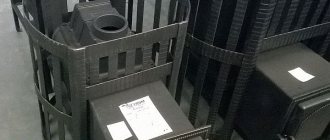Stainless steel has been a strategic raw material since the days of developed socialism. After all, the vast majority of Soviet missiles, airplanes and moonshine stills were made from it. True, the price for it, in those distant and glorious times, was quite affordable. As a rule, transferring a standard size stainless steel sheet was equivalent to one bottle of vodka and two toffees. Now the conditions have changed. For strategic raw materials and the price has become strategic. A tank for a stainless steel bath has become equal in cost to a serious investment. How correct is this and how fully justifies the money spent? Let's figure it out.
Water tanks are an integral part of any bathhouse.
Usually two tanks are used - for cold and hot water. And if the requirements for the first are not too high, then the second should be chosen very carefully, taking into account all possible factors. There are many types of tanks, and they differ not only in shape and material, but also in the installation method.
- it should heat up quickly;
- have high resistance to corrosion;
- withstand high temperatures;
- easy to clean;
- have sufficient capacity.
Purpose
A water tank is a reservoir designed to organize hot water supply. Regardless of the type and volume, it has an opening for cold water, as well as shut-off and distribution valves for hot water.
Hot water in the bathhouse is used mainly for washing after the steam room. In addition, it is necessary for household needs and washing. Finally, hot water in the steam room serves as an additional way to heat the room and get hot steam, which is so beneficial for health.
Which material to choose?
Cast iron tanks
The popularity of cast iron tanks has decreased markedly with the advent of stainless steel tanks. However, in most old baths you can see just such tanks, traditionally bowl-shaped, built into the stove. Large tanks were additionally secured with metal chains suspended from the ceiling beams to reduce the load on the stove.
Water boiler suspended on chains in a black bathhouse
Advantages of cast iron:
- very durable material;
- has the ability to retain heat for a long time;
- not subject to corrosion;
- resistant to high temperatures;
- easy to clean from dirt.
Flaws:
- weighs a lot;
- takes a long time to warm up.
Enameled tanks
Enameled steel containers are excellent as remote tanks. In the absence of direct contact with fire and careful handling, they are very durable. There are models for installation on a pipe, mostly rectangular in shape. The most important thing when installing and operating enameled tanks is to avoid mechanical damage. In places where the enamel is chipped, unprotected metal begins to rust very quickly. Minor damage can be repaired with special paint, but if the chips are large, the tank will have to be replaced.
Advantages:
- relatively light weight;
- aesthetic appearance;
- ease of care.
The only disadvantages of enameled products include low resistance to mechanical damage.
Stainless steel tanks
The most popular type of sauna tanks. Due to the variety of models, such tanks can be mounted in any of the described ways - built into stoves, mounted on a wall or around a chimney. The main thing here is to choose the right wall thickness and container volume.
Stainless steel tanks of various shapes and sizes
Advantages:
- long service life;
- resistance to deformation and corrosion;
- light weight;
- variety of models in shape and size;
- hygiene;
- heat resistance;
- high thermal conductivity;
- attractive appearance.
Open stainless steel tank in a bathhouse
Flaws:
- high price;
- cool quickly.
DIY sauna tank
Recommendations for installation and connection of a remote tank to a heat exchanger
The task is to conduct hot water from a heat exchanger installed on the chimney to a hanging tank in the washing compartment located behind the wall. It is more comfortable to steam and wash in different rooms.
The liquid heated in the heat exchanger should flow by gravity into the tank. From there it can be spent on hygiene procedures, after which cold water is refilled into the tank, which goes through the pipeline to the heat exchanger for heating.
The heat exchanger is equipped with pipes for connecting the circuit. The threads at their ends facilitate installation work.
Table. What will you need to connect?
| Name of tools and materials | Illustration |
| Name of tools and materials | Illustration |
| Bulgarian | |
| Hammer | |
| Screwdriver | |
| adjustable wrench | |
| Level | |
| Corrugated pipe | |
| Couplings | |
| Self-tapping screws | |
| Linen | |
| Plumbing paste | |
| Ball Valves | |
| Tee |
Prices for sanitary paste
plumbing paste
Step 1 . Pipeline exit points are measured, after which holes are drilled for hot and cold water pipes.
This is not always easy to do, given the thickness of the walls.
Step 2. Hanging a stainless steel remote tank. To do this, you need to tighten two self-tapping screws.
All measurements must be made using a level.
The tank is fixed using a wall mount.
Step 3 . Connections between pipes and pipes must be sealed. You can use Tangit Uni-Lock thread or sealant for this. If these materials are not available, it is recommended to use plumbing paste and flax, which are not a problem to buy. The paste is applied to the thread, after which the fiber is wound (it must be carefully straightened).
This connection is reliable. After this, you can tighten the nuts using an adjustable wrench.
It should be noted that poorly performed sealing will lead to water leaks. The same must be done on the heat exchanger.
Step 4 . Pipeline connection. The heat exchanger is connected via a flexible stainless corrugated pipe. You can adjust it to size using a grinder.
The second end of the hot line is connected to the (upper) pipe of the heat exchanger.
It is necessary to provide an elbow at the bottom of the circuit and install a ball valve to drain water before the onset of winter (no liquid should remain in the pipes, heat exchanger, or tank in a cold room). This tap should be located at the lowest point.
A hot water outlet is also installed (supplied to the tap).
The result is this design.
The heat exchanger looks like this: a pipe is connected to the upper pipe for discharging hot liquid, and to the lower pipe for supplying cold water from the tank.
Step 6. All that remains is to fill the tank and test run the system.
It must be remembered that water should be poured into the tank before the stove starts heating. Otherwise, the entire system will simply break apart.
Other selection criteria
Volume of the tank
In order not to make a mistake with the size of the tank, it is enough to make a simple calculation. On average, one person needs a bucket of water for washing, that is, 8-10 liters. Knowing how many people will visit the bathhouse regularly, you just need to multiply this number by 10 and add another 20-25 liters in reserve.
| Photo | Volume | Dimensions | Material and thickness | Approximate price |
| Tank on the wall | 60 l | 500x505x250 mm | stainless steel, 1 mm | RUB 3,990 |
| Tank on the wall | 31 l | 500x365x170 mm | stainless steel, 1 mm | RUB 3,290 |
| Tank on the wall | 80 l | 450x600x300 mm | stainless steel, 1 mm | RUB 9,690 |
| Tank on the wall | 90 l | — | stainless steel | RUB 4,410 |
| Tank on a pipe (for Dobrostal stoves) | 52 l | 385x385x830 mm | stainless steel, 1.5 mm | 6,900 rub. |
Installation method
Several factors are important here: the performance of the stove, the area of the steam room, the volume of the container. If the room is spacious and the stove is small, it is not advisable to reduce its performance with a built-in tank of 60 liters or more. In this case, the tank must be made remote or mounted on a pipe. If the steam room is small and the efficiency of the stove is high, the water in the small tank will quickly boil away. That is why it is necessary to carefully analyze all the conditions and select the optimal solution.
Convenience in the bathhouse also means a lot. The tank should be located so that the risk of getting burned on a hot surface is minimal, and water intake is convenient. If the container is located high (remote or samovar type), a tap is needed to supply hot water. Drawing water through the top is very inconvenient and unsafe.
If you carefully study the conditions, think through and weigh everything, choosing a hot water tank will not be difficult. With a well-chosen design, bath procedures will bring you only comfort and pleasure for many years.
Approximate cost of stainless steel and enameled tanks
| Tank type | Height | Volume | Wall thickness, mm | Cost, rub. |
| Tank type | Height | Volume | Wall thickness, mm | Cost, rub. |
| Samovar-type enameled tank | 550 mm | 50 l | 1,5 | 5620 |
| Samovar-type enameled tank | 600 mm | 63 l | 2 | 6099 |
| Stainless steel external vertical tank | 580 mm | 60 l | 1 | 4500 |
| Horizontal stainless steel tank | 470 mm | 60 l | 1,5 | 4500 |
| Samovar-type stainless steel tank | 500 mm | 43 l | 0,8 | 3500 |
| Samovar-type stainless steel tank | 700 mm | 60 l | 1,5 | 6080 |
Video - How to choose a water tank for the stove
Video - Remote tank for the oven
How does the system work?
Heat from the stove is transferred to the register or water jacket of the heat exchanger, which leads to an increase in the temperature of the coolant. Since the water in the tank has a lower temperature, pressure is created that promotes gravity flow of the liquid. Thus, hot water enters the tank, and cold water enters the heat exchanger through a pipeline, where it is heated (from the bottom point of the tank, water should be supplied to the bottom point of the heat exchanger, and from the top point of the heat exchanger, water should accordingly go to the top point of the tank). The minimum pipe diameter is 3/4 inch. The process continues until the temperature in the oven drops.
Important! The tank must be higher than the heat exchanger, otherwise water circulation will not be ensured.
Without installing a pump, the total length of the pipes between the heat exchanger and the remote tank should not be more than 3 m. There is also a nuance in the principle of the pipeline design. It is necessary to create a slope to ensure natural circulation of the coolant: the pipes connecting the heat exchanger to the tank must have a slope of at least 25...30 degrees, and those delivering water from the heat exchanger to the tank must have a slope of at least 250 degrees.
Installing a heat exchanger allows you not only to do without a water heater in the tank, but also to transfer heat to all rooms.
The heat exchanger must be chosen wisely. It should not reduce the performance of the heater by taking away a significant amount of heat from it. The maximum that it can take is 10% of the generated thermal energy.
If it is not possible to organize the movement of water by gravity, you can supplement the system with a circulation pump. This will increase its effectiveness. It will be possible to increase the length of the pipeline and reduce the slope. But the operation of this equipment is only possible from a 220 V electrical network.
Circulation pump pressure calculator
Go to calculations
Important! When operating water supply systems, remember that it is forbidden to heat the heater if the tank is empty. Otherwise, the welds may come apart. We also must not forget that in winter, water must be removed from the system (if the bathhouse is not heated), since when it freezes it can break the structure.
Since when installing water supply in a bathhouse it is often impossible to do without a circulation pump, which ensures the movement of liquid in a closed circuit, 5 of the best models are offered.










